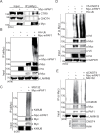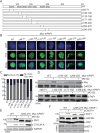Protein Degradation of RNA Polymerase II-Association Factor 1(PAF1) Is Controlled by CNOT4 and 26S Proteasome
- PMID: 25933433
- PMCID: PMC4416890
- DOI: 10.1371/journal.pone.0125599
Protein Degradation of RNA Polymerase II-Association Factor 1(PAF1) Is Controlled by CNOT4 and 26S Proteasome
Abstract
The PAF complex (PAFc) participates in various steps of the transcriptional process, from initiation to termination, by interacting with and recruiting various proteins to the proper locus for each step. PAFc is an evolutionarily conserved, multi-protein complex comprising PAF1, CDC73, CTR9, LEO1, yRTF1 and, in humans, hSKI8. These components of PAFc work together, and their protein levels are closely interrelated. In the present study, we investigated the mechanism of PAF1 protein degradation. We found that PAF1 protein levels are negatively regulated by the expression of CNOT4, an ortholog of yNOT4 and a member of the CCR4-NOT complex. CNOT4 specifically controls PAF1 but not other components of PAFc at the protein level by regulating the polyubiquitination of PAF1 and its subsequent degradation by the 26S proteasome. The degradation of PAF1 was found to require nuclear localization, as no PAF1 degradation by CNOT4 and the 26S proteasome was observed with NLS (nucleus localization signal)-deficient PAF1 mutants. However, chromatin binding by PAF1 was not necessary for 26S proteasome- or CNOT4-mediated degradation. Our results suggest that CNOT4 controls the degradation of chromatin-unbound PAF1 via the 26S proteasome.
Conflict of interest statement
Figures






Similar articles
-
CNOT4 suppresses nonsmall cell lung cancer progression by promoting the degradation of PAF1.Mol Carcinog. 2023 Oct;62(10):1563-1571. doi: 10.1002/mc.23599. Epub 2023 Jul 26. Mol Carcinog. 2023. PMID: 37493105
-
The Paf1 complex is required for RNA polymerase II removal in response to DNA damage.Proc Natl Acad Sci U S A. 2022 Oct 4;119(40):e2207332119. doi: 10.1073/pnas.2207332119. Epub 2022 Sep 26. Proc Natl Acad Sci U S A. 2022. PMID: 36161924 Free PMC article.
-
Ubiquitin-proteasome system regulation of a key gene regulatory factor, Paf1C.Gene. 2024 Feb 5;894:148004. doi: 10.1016/j.gene.2023.148004. Epub 2023 Nov 15. Gene. 2024. PMID: 37977317
-
The complexity of recognition of ubiquitinated substrates by the 26S proteasome.Biochim Biophys Acta. 2014 Jan;1843(1):86-96. doi: 10.1016/j.bbamcr.2013.07.007. Epub 2013 Jul 18. Biochim Biophys Acta. 2014. PMID: 23872423 Review.
-
[Non-canonical activities of the proteasomes].Tsitologiia. 2014;56(5):331-9. Tsitologiia. 2014. PMID: 25696972 Review. Russian.
Cited by
-
Ubiquitination-dependent control of sexual differentiation in fission yeast.Elife. 2017 Aug 25;6:e28046. doi: 10.7554/eLife.28046. Elife. 2017. PMID: 28841135 Free PMC article.
-
The Regulatory Properties of the Ccr4-Not Complex.Cells. 2020 Oct 29;9(11):2379. doi: 10.3390/cells9112379. Cells. 2020. PMID: 33138308 Free PMC article. Review.
-
Cnot4 heterozygosity attenuates high fat diet-induced obesity in mice and impairs PPARγ-mediated adipocyte differentiation.PLoS One. 2025 May 27;20(5):e0316417. doi: 10.1371/journal.pone.0316417. eCollection 2025. PLoS One. 2025. PMID: 40424271 Free PMC article.
-
Of Mice and Men: Proteasome's Role in LPS-Induced Inflammation and Tolerance.Shock. 2017 Apr;47(4):445-454. doi: 10.1097/SHK.0000000000000743. Shock. 2017. PMID: 27648699 Free PMC article.
-
USP37 Deubiquitinates CDC73 in HPT-JT Syndrome.Int J Mol Sci. 2022 Jun 7;23(12):6364. doi: 10.3390/ijms23126364. Int J Mol Sci. 2022. PMID: 35742816 Free PMC article.
References
Publication types
MeSH terms
Substances
LinkOut - more resources
Full Text Sources
Other Literature Sources

